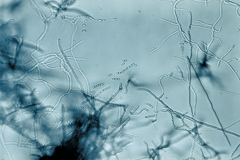Streptomyces facts for kids
Streptomyces are a special type of bacteria. There are more than 500 different kinds of Streptomyces! Even though they are bacteria, they grow in a way that makes them look a bit like fungi. They form long, thin threads, which are called hyphae. But remember, they are not fungi at all!
Quick facts for kids Streptomyces |
|
|---|---|
 |
|
| Slide culture of a Streptomyces species | |
| Scientific classification | |
| Kingdom: | |
| Phylum: | |
| Class: |
Actinobacteria
|
| Order: |
Actinomycetales
|
| Genus: |
Streptomyces
Waksman & Henrici 1943
|
Just like other Actinobacteria, Streptomyces are known as "gram-positive." This is a way scientists classify bacteria based on their cell walls. They also have a special kind of genetic makeup.
Contents
Where Streptomyces Live
Most Streptomyces bacteria live in the soil. You can also find them in decaying plants and other natural materials. They help break down dead things, which is super important for the environment.
How They Grow and Reproduce
Streptomyces reproduce by making tiny spores. These spores can spread and grow into new bacteria. This is how they multiply and spread in their habitats.
Streptomyces: Our Medicine Makers
Streptomyces are incredibly important to us! They produce more than two-thirds of the antibiotics we use today. These are medicines that fight off bad bacteria and help us get better when we're sick.
Famous Medicines from Streptomyces
Some well-known antibiotics that come from Streptomyces include tetracycline, neomycin, and chloramphenicol. The antibiotic called streptomycin even got its name directly from these amazing bacteria!
Streptomyces is the biggest group of bacteria that makes antibiotics. They create medicines that fight bacteria, fungi, and even parasites. They also make other helpful compounds, like those that can calm down our immune system.
When They Make Medicines
Almost all of these helpful compounds are made when the Streptomyces hyphae are just starting to form. It's like they are most active in making these special chemicals during their early growth.
See also
 In Spanish: Streptomyces para niños
In Spanish: Streptomyces para niños

